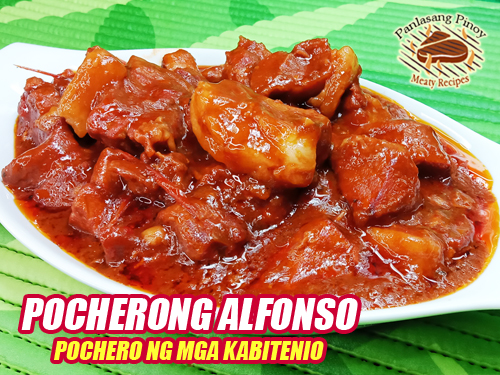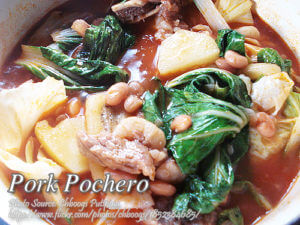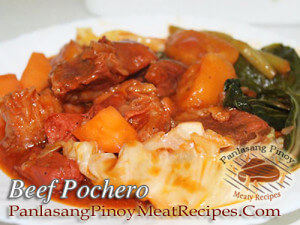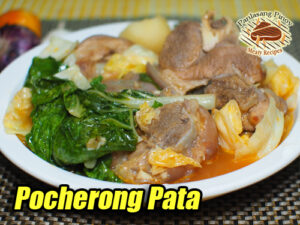This pork dish is a very unique pochero dish because it does not have vegetables like pechay, saba bananas or cabbage and the sauce is very different from the usual pochero. It is more like a mechado when you see the texture and also the taste. One peculiar thing on this dish is it it has bell peppers which is the only vegetable you can see on this dish. The pocherong alfonso is very popular in Alfonso Cavite and I think it was passed down from generations and it was always present in their gatherings and celebrations like fiestas or holidays.
Pocherong Alfonso: A Taste of Tradition and Warm Memories
Growing up, our family gatherings always centered around food. The dining table was where we bonded, laughed, and shared stories, and one dish that stood out during special occasions was pocherong alfonso. While most of us associate pochero with its hearty mix of vegetables and saba bananas, this version from Alfonso, Cavite, stands apart with its simplicity and robust flavor.
I first encountered this unique take on pochero when my uncle, Tito Ramon, visited us from Cavite. He proudly claimed it as a family treasure, passed down from his grandmother. He reminisced about how this dish was a staple during fiestas in their hometown, a reflection of Caviteños’ love for rich, flavorful cuisine. It’s not your typical pochero—it has no leafy greens, no saba bananas, and no cabbage. Instead, its sauce is reminiscent of mechado, with a velvety, savory sweetness that clings to each tender chunk of pork.
A Unique Pochero from Alfonso, Cavite
What makes it so special is its simplicity. The only vegetable you’ll find in this dish is bell pepper, which lends a subtle sweetness and mild heat. At first, I found it odd not to see pechay or potatoes in the recipe. But as Tito Ramon explained, the lack of additional vegetables allows the rich, tangy sauce to shine. The dish’s vibrant flavor comes from a harmonious blend of banana ketchup, pineapple juice, and tomato sauce—an ingenious mix that highlights the Filipino knack for balancing sweet, salty, and sour notes.
Tito also shared a fun tidbit: the name “Pocherong Alfonso” is a nod to its hometown, Alfonso. He recalled how his grandmother would always prepare this dish for Noche Buena or during town fiestas. It became a symbol of celebration, a dish that brought people together.
Marinating: The Key to Bold Flavors
One of the most essential steps in making the dish is marinating the pork. The marinade is a combination of soy sauce, banana ketchup, pineapple juice, tomato sauce, pickle relish, calamansi juice, garlic, onions, and bell peppers. These ingredients may seem simple, but together, they create a symphony of flavors.
Marinating the pork for at least an hour not only tenderizes the meat but also infuses it with a rich, tangy flavor that penetrates every bite. The acidic pineapple juice breaks down the meat fibers, while the soy sauce and ketchup add depth and a touch of sweetness. This step is non-negotiable—trust me, it’s what makes the dish unforgettable.
The Secret to a Perfectly Balanced Sauce
When it comes to the sauce, the combination of ingredients might remind you of mechado or caldereta, but there’s a distinct sweetness and tanginess in pocherong alfonso that sets it apart. Cooking the marinated pork in its marinade allows the sauce to reduce and thicken naturally, creating a rich, glossy coating for the meat.
I remember my sister, Ana, who’s an aspiring chef, telling me about the importance of sautéing garlic and onions in margarine for this recipe. The margarine adds a subtle creaminess to the sauce, elevating its flavor and giving it a nostalgic, old-school vibe. The bell peppers, added early in the process, soften and meld beautifully with the sauce, making each spoonful a burst of umami.
Pocherong Alfonso Best Served with Steamed Rice
Tito Ramon always emphasized that pocherong alfonso is best enjoyed with steamed white rice. He would pile a generous serving of rice on his plate, ladle the glossy sauce over it, and top it with the tender pork pieces. The rich, savory-sweet sauce seeps into the rice, creating a perfect harmony of flavors.
It’s one of those dishes that’s deceptively simple yet deeply satisfying. And while it might not have the typical vegetable medley of traditional pochero, its bold, comforting flavors make it a worthy centerpiece for any celebration.
A Slice of History on Your Plate
Did you know that pochero traces its roots to Spanish colonial times? The term “pochero” comes from the Spanish word puchero, which means “stewpot.” Over the centuries, Filipinos have made the dish their own, incorporating local ingredients like banana ketchup and calamansi. Pocherong alfonso is a testament to this culinary evolution—a localized version that reflects the ingenuity and resourcefulness of Filipino cooks.
As you cook this dish, take a moment to appreciate its rich history and the stories it carries. In every bite, you’re not just tasting a meal; you’re savoring a piece of Alfonso, Cavite’s culture and tradition.
Try Pocherong Alfonso Today
Whether you’re preparing for a family gathering or simply looking to try something new, this is a dish that promises to impress. Its rich, tangy sauce, tender pork, and comforting flavors make it a recipe worth keeping in your repertoire.
So the next time you’re in the kitchen, channel the spirit of Alfonso, Cavite, and bring this dish to life. Who knows—it might just become a family favorite in your home, too.
How to Cook Pocherong Alfonso
Ingredients
- 1 kilo pork butt or shoulder cut into large cubes
- 1 cup banana ketchup
- 1 cup pineapple juice
- 1 cup tomato sauce
- 1/2 cup soy sauce
- 1 to 2 pcs red bell peppers sliced into strips
- 1 Tbsp. pickle relish
- 12 cloves garlic minced
- 2 pcs onions chopped
- 2 pcs kalamansi extract the juice
- 3 Tbsp. margarine
- 1 Tbsp. patis
- salt and pepper to taste
Instructions
How to Cook Pocherong Alfonso:
- Slice the pork into large cubes. Put in a large mixing bowl.
- Add in the marinade ingredients in the bowl: soy sauce, banana ketchup, pineapple juice, tomato sauce, pickle relish, half of garlic, half of onions, bell peppers, kalamansi, salt and pepper.
- Stir all the ingredients in the bowl then cover and marinate for 1 hour.
- In a pot or wok, melt the margarine and saute the remaining garlic and onions until onions are soft.
- Then add in the marinated pork with the marinade. Bring to a boil and simmer for 1 hour or until the pork tender.
- Serve hot with steamed rice.
Video
Notes
Cooking Tips:
Marinate the Pork for Maximum Flavor
Marinating the pork is essential to achieve the bold, savory-sweet flavors of the dish. Allow the pork to sit in the marinade for at least an hour to let the pineapple juice, soy sauce, and spices fully penetrate the meat. This step ensures the pork stays tender and flavorful throughout the cooking process.Use Margarine for a Richer Sauce
Sautéing garlic and onions in margarine instead of oil adds a subtle creaminess to the dish, elevating the overall flavor profile. The margarine also helps bind the sauce, creating a glossy texture that clings beautifully to the pork. It’s a small change that makes a big difference in the richness of the sauce.Simmer Low and Slow for Tender Pork
Cooking the marinated pork over low heat allows the flavors to meld and ensures the meat becomes melt-in-your-mouth tender. Avoid rushing this step, as the slow simmering process also thickens the sauce naturally. The result is a dish that’s perfectly cooked with layers of deep, comforting flavor.

Pocherong Alfoso Photo




